Guided by the principles of science and technology, data mining is a strategic process designed to uncover patterns, correlations, and trends beneath the informational surface.
In this article, we will explore what data mining is, its techniques, tools, best practices, and examples.
What is data mining?
Data mining is a computational process for discovering patterns, correlations, and anomalies within large datasets. It applies various statistical analysis and machine learning (ML) techniques to extract meaningful information and insights from data. Businesses can use these insights to make informed decisions, predict trends, and improve business strategies.
For example, with the help of data mining, a travel business may discover that solo travelers frequently book hotels closer to tech hubs or coworking spaces, even when these are situated away from main tourist attractions. This could suggest that a significant number of solo travelers are blending work and leisure travel, preferring locations that cater to their professional needs. This insight may guide the company to focus its marketing campaigns on hotels with business-friendly amenities or proximities to coworking spaces.
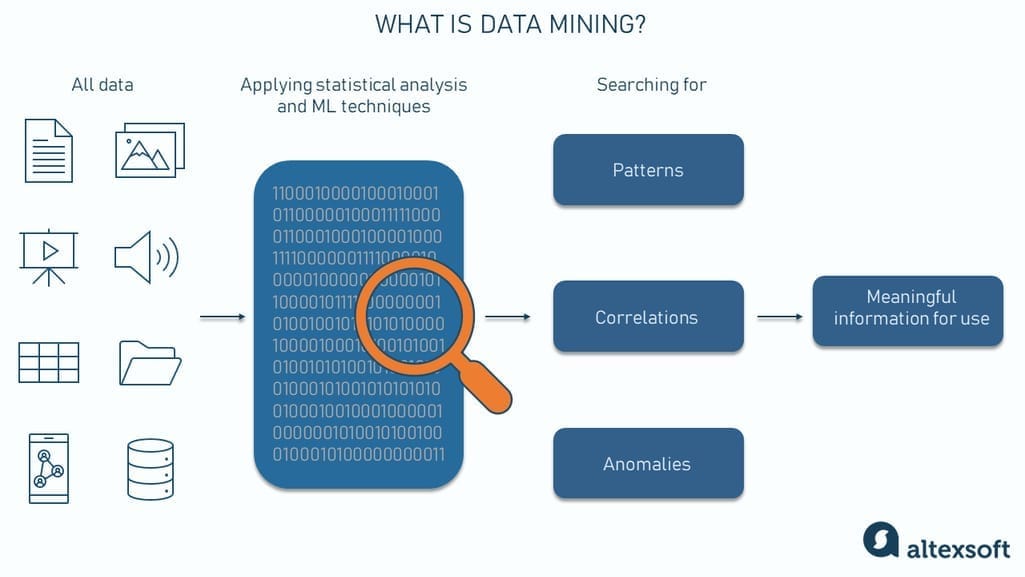
The illustrative definition of data mining
This process is essential in transforming large volumes of raw data — structured, unstructured, or semi-structured — into valuable, actionable knowledge.
Brief data mining history
Data mining emerged as a distinct field in the 1990s, but you can trace its conceptual roots back to the mid-20th century. The original term for data mining was "knowledge discovery in databases" or KDD. The approach evolved as a response to the advent of large-scale data storage (e.g., data warehouses and data lakes). Such big repositories could store a lot of data. What logically followed was the need to make sense of all that information.
The further development of data mining went hand in hand with the growth of powerful computing capabilities and increasing data availability, enabling the practical analysis of more complex and voluminous datasets.
Data mining vs machine learning
It’s easy to confuse data mining with other data-related processes, like machine learning.
The general distinction is that data mining focuses on finding patterns and relationships in data, and machine learning is more about building algorithms on existing data to make predictions or decisions about future data.
The processes are interconnected, not mutually exclusive: ML often uses data mining results as input, while data mining uses ML techniques to understand what information lurks beneath the surface.
For instance, in the travel business, data mining might involve analyzing several years of booking records and customer feedback to uncover popular destinations and travel trends. In contrast, machine learning would be like developing a system that recognizes current travel trends and predicts future travel behaviors and preferences based on past data.
The exciting thing is that both data mining and machine learning fall under a more general and broader category of data science. If you still have issues understanding the differences, we suggest you read our dedicated article, "Data Science vs Machine Learning vs AI vs Deep Learning vs Data Mining.”
Data mining advantages
Saying that data mining can be highly advantageous to businesses is a bit generic — but true. To prove this point, below is a list of critical benefits.
Data mining
- provides deep, actionable insights, enabling more informed and strategic business decisions;
- allows for more accurate forecasting of market trends and customer behavior, aiding in proactive business planning;
- helps uncover hidden patterns and correlations, leading to a better understanding of market dynamics and customer needs;
- aids in the identification of outliers and unusual data patterns, crucial for fraud detection and maintaining operational integrity;
- enables the creation of more effective, personalized marketing campaigns by analyzing customer data; and
- helps assess and mitigate potential risks more accurately.
Of course, there are more useful things, and you will see them further in the text.
How does data mining work: Key steps of the data mining process
Published in 1999, the Cross Industry Standard Process for Data Mining (CRISP-DM) is a structured approach to perform data mining in six sequential phases. Many specialists still rely on this comprehensive framework to standardize industry data mining processes. Let's explore the CRISP-DM phases in more detail.
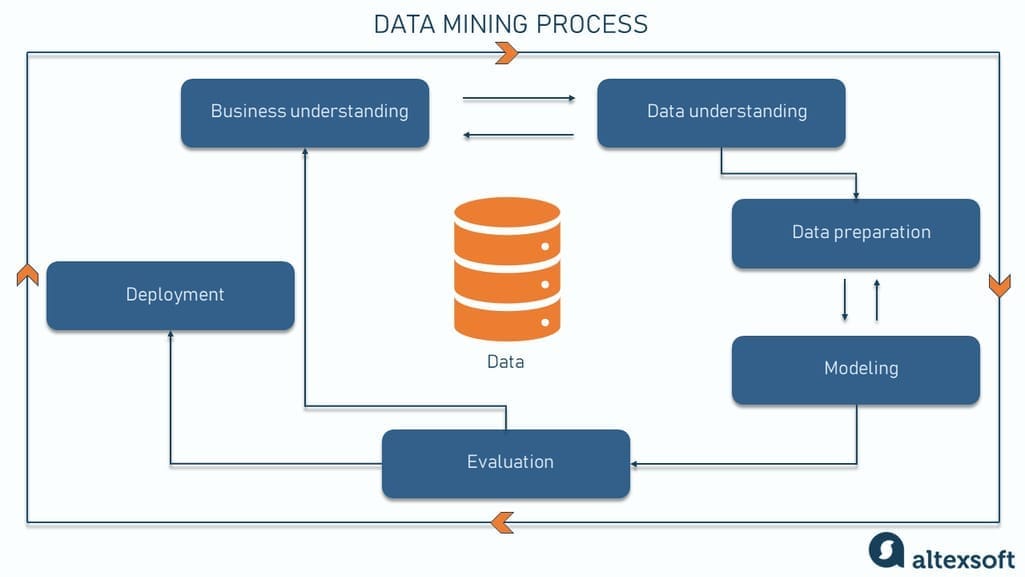
Process diagram showing the relationship between the different stages of data mining. Source: Data Science Process Alliance
Business understanding. Just like reading instructions before taking meds, you make general preparation moves before starting the data mining process. And the initial phase focuses on understanding the data project objectives and requirements from a business perspective. It involves defining the scope of the problem, identifying key business questions that data mining needs to address, and formulating an initial plan to achieve the objectives.
Data understanding and collection. In this phase, data scientists start collecting and examining data to become familiar with it, identify its quality issues, and discover first insights. The process might include exploring the data's size, nature, and patterns and understanding the available data sources.
Data preparation. Often the most time-consuming phase, data preparation entails cleaning and transforming raw data into a suitable format for analysis. This process includes handling missing values, resolving inconsistencies, normalizing data, and potentially transforming variables. The goal is to develop a final dataset from the raw data for modeling.
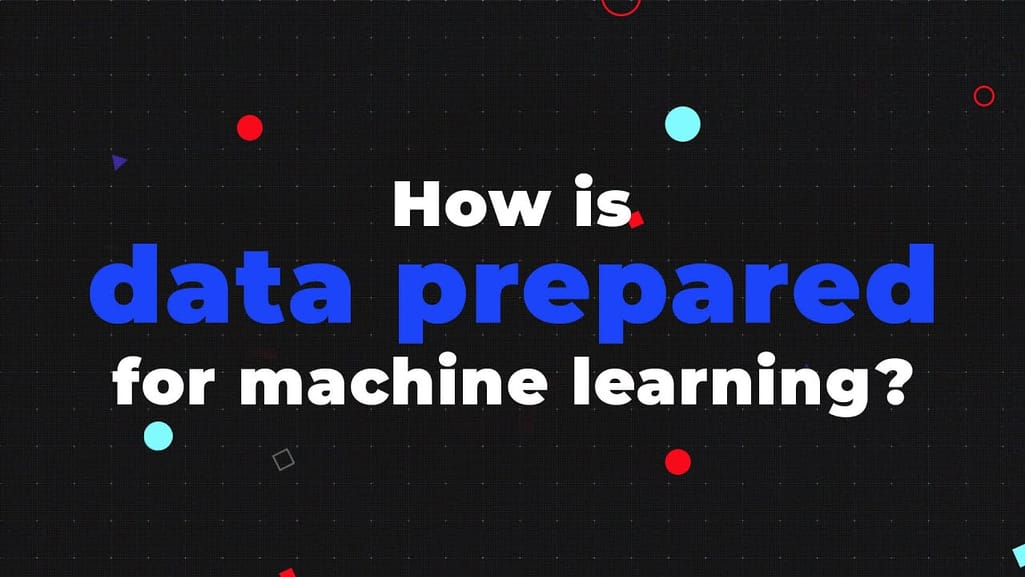

If you want to know how to prepare data for machine learning, we have an engaging 14-minute video explainer.
Modeling. In this stage, data mining specialists decide what mathematical techniques to use on their data. It’s a good practice to try different algorithms and models to identify the best approach for pattern recognition and prediction based on the prepared data. Techniques can range from simple regression models to complex neural networks, depending on the problem. We’ll explain the key ones further in the text.
Evaluation. This phase often involves assessing the model's accuracy, reliability, and validity. Accuracy checks how often the model provides correct results. Reliability deals with the model’s consistency: If you use the model multiple times, does it give you the same results each time? Validity is about making sure the model predicts what it is supposed to. Evaluation might include iterating and fine-tuning the model to improve its performance.
Deployment. Deployment can range from generating a report with insights and recommendations based on outcomes to integrating a data mining model into the company’s operational systems. The final stage should ensure that you can effectively translate the insights from data mining into actionable business strategies or decisions.
Each phase in the CRISP-DM process is iterative, meaning that insights or issues discovered in a later phase might lead back to revising earlier steps. This cyclical nature ensures continuous improvement and relevance of the data mining project to the business objectives.
Types of data mining: Key data mining techniques and methods
As promised, here we will explain the fundamental data mining techniques. Data mining can be broadly categorized into two main types — predictive data mining and descriptive data mining. Each type serves distinct business needs and offers unique insights.
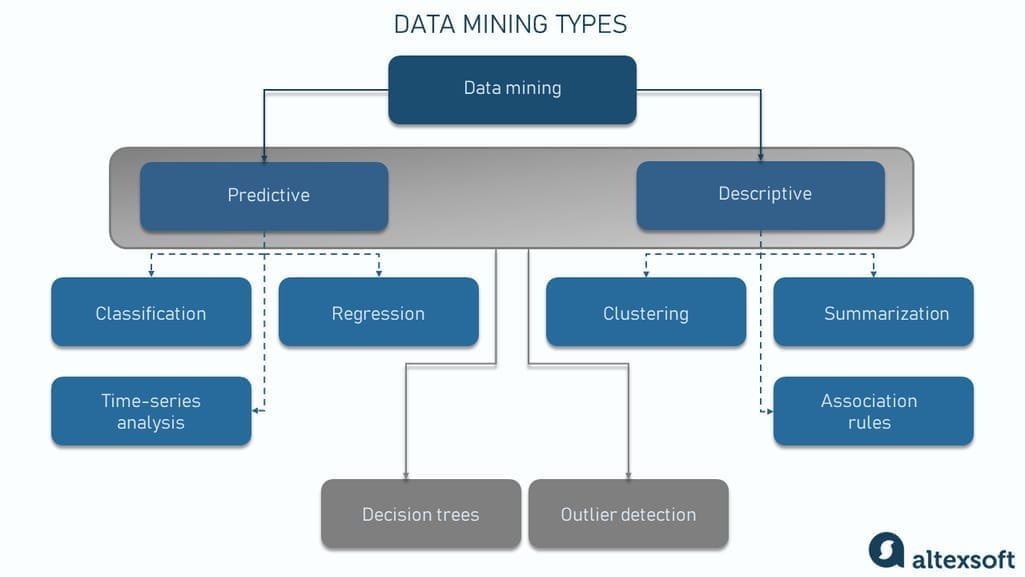
Data mining types and techniques
However, some data mining techniques are flexible: Specialists can use them in predictive and descriptive contexts, depending on their application. We can categorize these versatile techniques under a separate heading to acknowledge their dual nature.
Predictive modeling
Predictive data mining involves analyzing current and historical data to forecast future events. It's particularly useful for scenarios where it is crucial to understand trends, patterns, and probable outcomes. For example, in the healthcare industry, predictive data mining can be used to analyze patient data and medical records to predict disease outbreaks, identify risk factors for certain conditions, and improve patient care through personalized treatment plans.
Predictive data mining can be further categorized into several key techniques:
- Classification
- Regression
- Time-series analysis
Classification is sorting data into predefined categories. It examines data attributes to determine which class each data item belongs to. After identifying the key characteristics of data, you can systematically group or classify related data.
For example, an airline might classify customers based on travel frequency and spending patterns. It can identify frequent business travelers who purchase premium services and leisure travelers who prefer low-cost flights. Then the airline can offer specific loyalty programs and personalized offers to enhance customer experience and loyalty.
Regression is used to identify and analyze the relationships between different variables in data. The main purpose of regression is to create a model that can estimate the value of one variable (the dependent variable) based on how other variables (independent variables) change.
For example, a hotel chain might use regression to analyze past booking data and pricing strategies to forecast revenue for different times of the year.
Time-series analysis is a specialized technique for analyzing and interpreting data collected at regular time intervals. This method is particularly useful for identifying trends, seasonal patterns, and cyclical behaviors. Unlike other data mining methods that deal with static information, time-series analysis focuses on data that changes over time.
Airlines frequently use time-series analysis to forecast passenger demand. By examining historical data on flight bookings, cancellations, and passenger numbers over time, an airline can identify peak travel periods, seasonal variations, and long-term demand trends.
Descriptive modeling
Descriptive data mining focuses on summarizing and understanding the characteristics of historical data. It seeks to derive patterns, relationships, and structures from existing data, which helps understand the data’s underlying behavior. The techniques in descriptive data mining include:
- Clustering
- Summarization
- Association rules
Clustering groups various data points based on similarities, forming clusters wherein members have more in common than those in other clusters. Unlike classification, which involves sorting data into predefined categories based on known attributes, clustering is exploratory, identifying inherent groupings in the data without preassigned labels.
For example, a cruise business can apply clustering to segment customers for more effective marketing. By examining data such as travel history, onboard spending, and demographics, cruise lines can discover natural groupings among their customers. One cluster may consist of families favoring child-friendly activities, while another might include retired couples seeking luxury experiences.
Summarization means reducing large datasets into a more manageable and understandable form without losing their essential information. This process involves extracting and presenting key features of the data, enabling a quick overview and understanding of its main characteristics.
Consider a large hotel chain with multiple locations worldwide. Summarization can be used to consolidate and present key operational data like occupancy rates, average room rates, and guest demographics across all properties. This could involve creating a concise report or dashboard that shows performance metrics at a glance.
Association rules is a descriptive data modeling technique that aims at discovering interesting relationships and associations between different variables in large datasets. Unlike summarization that condenses data or clustering and classification that group similar items, association rules identify patterns, connections, and co-occurrences between different items within the data. This technique is particularly valuable for uncovering patterns that might not be immediately apparent.
In the context of a hotel, association rules can help uncover relationships between the services used by guests. For example, an analysis might reveal that single travelers often prefer — and are more willing to pay a premium for — rooms that don't overlook the pool area. This pattern could indicate that these guests, possibly on business trips, seek quieter accommodations away from the potential noise of poolside activities.
Similarly, it could be found that families with children frequently request adjoining rooms and are likely to dine in the hotel's family-friendly restaurant.
Dual-use data mining techniques
As said, there are techniques that can be adapted for both predictive and descriptive data mining, making them valuable across various scenarios.
We’ll highlight such methods as
- Decision trees
- Outlier detection
Decision trees are technically machine learning algorithms, but they can be used in data mining for decision-making. Imagine a decision tree as a tree-shaped diagram: At each branching point, the tree asks a question about the data, and the path you take depends on the answer to that question. At the end of each branch is a prediction or decision. In classification tasks, these endpoints label the data into categories; in regression tasks, they predict a numerical value.
A car rental company can use decision trees to assess the risk of damage or the likelihood of late return for each rental. The tree might consider factors like rental duration, customer's rental history, type of car, and travel destination. Based on these inputs, the decision tree can help categorize rentals into different risk groups. For instance, a short-term rental of a standard car to a customer with a clean history might be considered low risk, while a high-performance car rented for a longer duration to a new customer might be higher risk.
Outlier detection is a critical data mining technique that identifies data points significantly differing from the majority of the data. These outliers can be due to variability in the measurement or may indicate experimental errors; in some cases, they can indicate a significant discovery or a new trend.
Consider a company that manages a fleet of trucks for cargo delivery. Outlier detection can help identify unusual patterns in fuel consumption, delivery times, or vehicle maintenance needs. For example, if one truck consistently shows higher fuel usage than others on the same route, it might indicate a maintenance issue or inefficient driving habits.
The data mining techniques we've discussed represent the tip of the iceberg of what is out there. You can find numerous other methods and algorithms, each with unique strengths and applications.
Additionally, it's important to highlight the growing role of neural networks in data mining. Today, deep learning models are increasingly being used for complex data mining tasks. These models are particularly good at handling large volumes of unstructured data, such as images, text, and sound, and are pushing the boundaries of what's possible in areas like pattern recognition, anomaly detection, and predictive analytics.
Data mining examples and use cases
The number of areas where data mining can be useful is huge. Below you will find the most popular cases where data mining can find its application.
Fraud detection, as the name suggests, deals with identifying any deceptive activities or transactions. Data mining techniques can be utilized here to analyze patterns and find anomalies in transaction data to flag potential fraud.
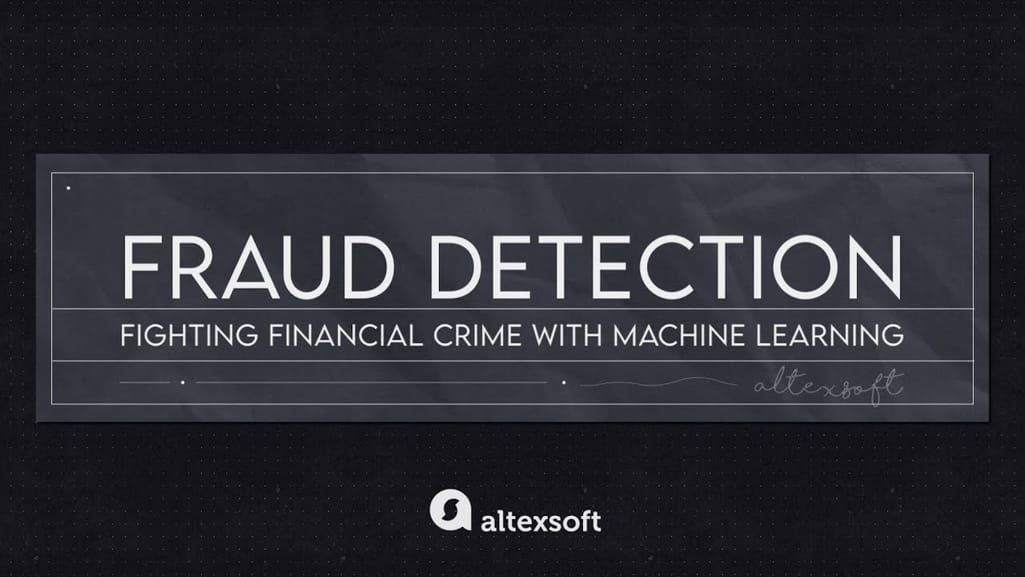

Learn about fraud detection in our dedicated video
Sales forecasting entails predicting future sales volumes. You can use data mining here to analyze historical sales data and customer buying patterns and help with sales forecasting.
Customer segmentation is the process that divides customers into distinct groups for targeted marketing. Data mining aids in analyzing customer data to identify segments based on behavior, preferences, or demographics, enabling personalized marketing strategies.
Risk management is identifying and mitigating potential risks within a business. For instance, data mining might reveal how certain decisions impacted financial stability or operational efficiency in the past. These insights enable businesses to address and mitigate risks proactively, reducing the chances of adverse future events.
Churn prediction involves predicting which customers are likely to stop using a service. Data mining helps by examining customer behavior and engagement patterns to identify those at risk of churning.
Sentiment analysis refers to gauging public opinion or sentiment from text data. Data mining helps analyze large volumes of text (like social media posts) to assess public sentiment toward products, services, or brands.
Demand forecasting is about predicting future demand for products or services. Data mining aids in this by analyzing past demand patterns, market trends, and other influencing factors to forecast future demand levels.
Data mining software
Various software and tools are available in data mining to suit different organizational needs. We can put these tools into several key categories.
Python libraries. Python is a versatile language with many libraries for data mining and analysis. Pandas is widely used for data manipulation capabilities, while NumPy is essential for numerical computations. Scikit-learn is another popular library offering a range of machine learning algorithms for data mining.
Visualization tools. Do you want to understand complex data sets? Then you need visualization tools. Different software systems, like Tableau and Power BI, offer more significant data analysis and visualization capabilities. Google Charts, for instance, provides a web-based solution for creating interactive charts, while Grafana works fine for real-time analytics and monitoring.
Data mining platforms. Comprehensive platforms that support the entire data mining process are essential for some organizations. KNIME and RapidMiner stand out for their user-friendly interfaces and extensive data processing and modeling capabilities. These platforms allow for efficient analysis and integration of data from various sources.
Each category of these tools, whether open-source or commercial, can significantly help with data mining, enabling businesses to extract, analyze, and act on data insights for better decision-making and strategic planning.
Data mining best practices and general recommendations
Starting a data mining project can be overwhelming. Here are some key recommendations for staying focused and doing everything right.
- Define upfront what you aim to achieve with data mining.
- Use accurate, relevant, clean data.
- Match techniques with your goals (classification, regression, etc.).
- Adhere to privacy laws and ethical standards.
- Continuously improve models and approaches.
- Test models on different data subsets to ensure reliability.
- Keep abreast of the latest trends and techniques in data mining.
- Work with experts and clearly communicate findings.
- Ensure results lead to practical actions or decisions.
- Enhance team capabilities with training and advanced tools.
By following these streamlined practices, you can effectively harness data mining to derive meaningful and actionable insights for informed decision-making.

